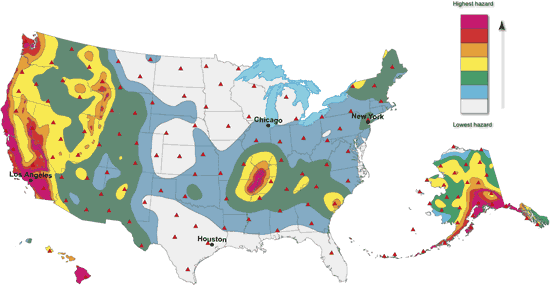|
Advanced National Seismic System

Existing and proposed ANSS stations & shaking hazards in the US.
The mission of ANSS is to provide accurate and timely data and information
products for seismic events, including their effects on buildings and
structures, employing modern monitoring methods and technologies.
This mission serves a basic function of the National Earthquake Hazards
Reduction Program , and
drives the four basic goals of the planned system:
- Establish and maintain an advanced infrastructure for seismic monitoring
throughout the United States that operates with high performance standards,
gathers critical technical data, and effectively provides information
products and services to meet the Nationís needs. An Advanced National
Seismic System should consist of modern seismographs, communication
networks, data processing centers, and well-trained personnel; such an
integrated system would constantly record and analyze seismic data and
provide timely and reliable information on earthquakes and other seismic
disturbances.
- Continuously monitor earthquakes and other seismic disturbances throughout
the UnitedStates, including earthquakes that may cause a tsunami or precede
a volcanic eruption, with special focus on regions of moderate to high
hazard and risk.
- Thoroughly measure strong earthquake shaking at ground sites and in
buildings and critical structures. Focus should be in urban areas and near
major active fault zones to gather greatly needed data and information for
reducing earthquake impacts on buildings and structures.
- Automatically broadcast information when a significant earthquake occurs,
for immediate assessment of its impact. Where feasible, for sites at
distance from the epicenter, broadcast an early warning seconds before
strong shaking arrives. Provide similar capabilities for automated warning
and alert for tsunamis and volcanic eruptions.
To achieve these goals, ANSS will establish nationwide network of over 7000
earthquake sensor systems, serving all areas of the country subject to
earthquake hazards and providing dense coverage in 26 at-risk urban areas
(see map). Sensors will be located both in the ground and in buildings and
other structures.
The system will provide real-time earthquake information for emergency
response personnel, provide engineers with information about building and
site response to strong shaking, and provide scientists with high-quality
data needed to understand earthquake processes and structure and dynamics of
the solid earth.
ANSS Funding.
|

